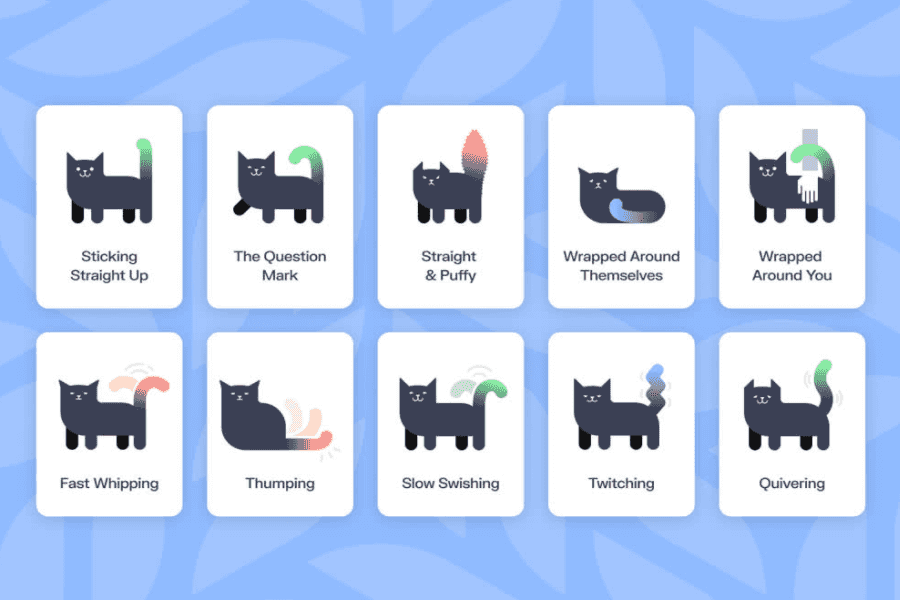What Does It Mean When Cats Wag Their Tails?

What Does It Mean When Cats Wag Their Tails? ![]()
Cats communicate in fascinating ways, and their tails have a language all their own. Unlike dogs, who wag their tails to convey friendliness and happiness, cat tail talk encompasses a broad range of emotions. Learning to interpret your cat’s tail signals provides valuable insight into their moods, needs and intentions.
From subtle twitches to dramatic swooshes, a cat’s tail movement often reveals more than their inscrutable facial expressions. With some dedicated observation and interpretation, you can become fluent in your cat’s nonverbal vocabulary. A wagging tail is frequently a signal requiring your attention and response.
Understanding what your cat means when they wag their tail will help strengthen your bond and improve their quality of life. This guide covers the meaning behind various cat tail positions and motions, providing the keys to comprehending kitty tail talk!
Anatomy of the Feline Tail

A cat’s tail contains 19 to 23 highly mobile vertebrae, making it extremely flexible and expressive. The vertebrae are connected by small joints and surrounded by muscles which allow it to bend, twitch and convey a spectrum of sentiments. A network of tendons and ligaments attaches the tail to the cat’s pelvis and lower spine.
The tail is an extension of the cat’s backbone and contains sensitive nerves. Nerve endings send signals directly to the cat’s brain, making the tail ultra responsive. A cat relies on their tail for:
- Balance and coordination when jumping, running and changing direction
- Communication through positioning and movement
- Social signaling of moods and intentions
- Defense and territorial displays by puffing up to appear larger
Now that you understand the tail’s physical makeup, let’s explore what your cat means when they put it into motion.
Slow Wagging or Waving Tail
A happy, content cat
When your cat is sitting or lying down looking relaxed, a slowly waving tail often signals happiness and contentment. As the tail lazily sweeps side to side, you may also notice rhythmic thumping as it taps against the floor. A mellow tail wag while your cat is in a calm state indicates all is well.
A focused cat
A slow, deliberate tail wag can also mean your cat is highly focused on something they see outside or a toy they are stalking. The intent gaze and waving tail means your cat is concentrating intently and getting ready to pounce!
Fast Wagging or Flicking Tail

An excited cat
A cat who is eager for something like feeding time or your return home will convey their anticipation through a fast tail wag. The rapid quivering shows their eagerness and readiness to engage. An excited cat is wired up and enthusiastic for what is about to happen!
An irritated cat
Rapid flicking back and forth can also suggest annoyance. Look for other irritated body language like folded back ears. Your cat may be signaling they don’t want to be touched at the moment. Or something in their environment is bothering them, like a loud noise.
A cat in pain
Subtle trembling or twitching while laying down occasionally happens when a cat is hurting. If the tail wagging seems involuntary rather than expressive of an emotion, pain may be the cause. Examine them for signs of injury or discomfort and contact your vet.
Side-to-Side Swishing Tail
A cat slowly swinging their tail from side to side generally indicates curiosity, uncertainty or mental focus. They are contemplating something that has caught their interest. This tail motion often accompanies a staring gaze while your cat is intently observing something like prey or another animal outside.
Stiff, Upright Tail
A confident cat
When your cat moves through the house with tail extended upright, this signals confidence and contentment. They are comfortable in their surroundings. An upright tail may also be how one cat greets another cat they are familiar with.
A startled cat
If your cat suddenly freezes with their tail sticking straight up, something has frightened them. Look for the source of their scare, such as another animal approaching outside. After the perceived danger passes, their tail will gradually lower from the alarmed upright position.
Lashing or Thrashing Tail

A cat rapidly thrashing their tail back and forth indicates fear, aggression or anger. They are feeling threatened by something in their environment and are displaying defensiveness.
Hissing or growling often accompanies tail thrashing. The cat is warning the source of their upset to back away.
This intense tail motion tells you to give your cat space until they calm down. Approaching them to offer comfort may result in bites or scratches from their agitated state. Allow your cat to regain composure before reintroducing yourself.
Tucked Tail
When your cat presses their tail tightly against or beneath their hindquarters, they are signaling fear or submission. A tucked tail makes a cat appear smaller while also keeping the sensitive tail safely out of harm’s way. This posture may also mean they are cold and trying to conserve body heat.
If your social and friendly feline is suddenly tucking their tail, look for what is causing distress. Loud noises, unfamiliar animals and other environmental changes can trigger this scared response. Offer reassurance and remove the source of fright when possible.
Wrapped Tail
A cat demonstrating friendship or affection may wrap their tail around your hand, arm or ankle. A tail wrap signifies trust and care, like holding hands between close companions. Cats also wrap tails together when sleeping or sitting near cats they have bonded with.
If your cat wraps you with their tail, recognize it as an expression of love. They feel safe and comfortable with you. Enjoy this contact and reciprocate with pets and cuddles!
Twitching Tail

Dreaming cat
When your cat is napping, you may notice sporadic twitching of their tail. These involuntary movements often indicate your cat is dreaming while asleep. Their instincts don’t rest, even when in slumber. Pleasurable dreams about hunting or playing can stimulate tail twitches.
Bothered cat
If your cat is awake but lazily twitching their tail, something is likely annoying or concerning them. Your cat could just be overstimulated or need some alone time. Look for other signals like ears turning back to ascertain if your cat is merely irritated or feeling distressed.
Question Mark Tail
When the tip of your cat’s upright tail curves into a question mark shape, this expresses friendly excitement. Their body language says they are sociable, upbeat, and enthused to interact! A question mark tail often accompanies purring and rubbing against your legs as they greet you.
Take this tail cue as an invitation to engage in some quality time. Give your cat affection, break out their toys and have some fun together!
Tail Flagging
You will notice your cat holding their tail upright while slowly walking with their hind legs on an object and front legs stepping off it. This scent marking behavior is called flagging, as your cat “flags” the object with the pheromones from glands on their paws and tail.
Cats can flag you, furniture, doorways or pretty much anything in your home. Though this claiming behavior is normal, redirect excessive flagging to more appropriate objects.
Tail Whip

If you attempt to pet your cat but they are not in the mood for fondling at the moment, they may whip their tail. This is a warning that your touch is unwanted. Respect their space. Forcing interaction can provoke irritated behavior or scratches from their claws.
Try petting again later when your cat solicits attention by rubbing on your or initiating play. This helps avoid overstimulating them with too much petting at inopportune times. Pay heed to their body language, and let your cat decide when tactile affection is welcome.
Understanding Cat Tail Language

Cats reveal so much about their state of mind through their articulate tails. Making the effort to comprehend tail talk and respond appropriately strengthens the bond between you and your remarkable feline. Here are some key tips for understanding what your cat means when they wag their tail:
Consider the speed: Slow wagging indicates a different emotional state than fast, thrashing movement. The pace of the tail conveys the cat’s level of arousal.
Note the position: Tail height, stiffness and posture all factor into the cat’s message. An upright tail can mean very different things than a tucked tail, for example.
Look for other body language: Ear position, vocalizations, pupil dilation and body posture provide additional context to interpret tail talk.
Factor in environmental cues: A sudden noise or unknown animal eliciting a tail response offers clues to your cat’s behavioral motivations.
Let your cat set the tone for play and petting: Overstimulation is a common trigger for tail whipping. Follow their lead on when physical interaction is wanted.
Be patient interpreting tail talk: It can take time observing patterns to fully grasp your cat’s tail language. Dedicated attention to their signals will keep improving your comprehension.
Cat Tail Talk Can Be Complex
While this overview covers the most common tail positions and movements, don’t be surprised if your cat sometimes sends less straightforward tail signals. For example, a tail thrashing back and forth can happen from overstimulation during play and not just fear or anger. Cats also convey mixed messages, like an uncertain newcomer with an upright but twitching tail.
Think of learning your cat’s tail body language like studying a foreign language. Fluency takes practice through applied observation in everyday situations. The more attentive you are to their tail talk vocabulary, the more intuitively you will translate the messages.
If you are ever puzzled by what your cat means when wagging their tail, look at their entire body and environment for additional interpretive context. When in doubt, give them space until the intention behind their tail talk becomes clearer. The reward of comprehending your cat’s communications is a deeper mutual understanding and bond.
Bottom Line
A cat’s tail language allows them to convey a rich range of emotions, needs and intentions despite their reserved nature. Take time observing and interpreting your cat’s tail motions and positions. The more attuned you become, the better you can respond to their communications. A wagging cat tail certainly grabs our attention. Make sure you comprehend the message behind the movement.
Strengthening your comprehension of your cat’s tail talk will lead to a deeper bond between you. You can better provide conditions that make your cat happy and comfortable when you understand their subtle yet meaningful tail signals. So sharpen your cat tail language fluency today for a more purrfect relationship!
Tags
Share
Table Of Contents
Related Posts
Quick Links

